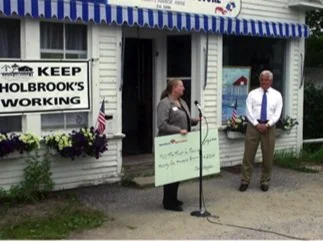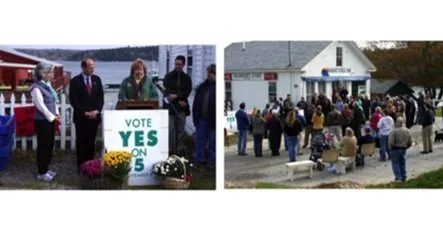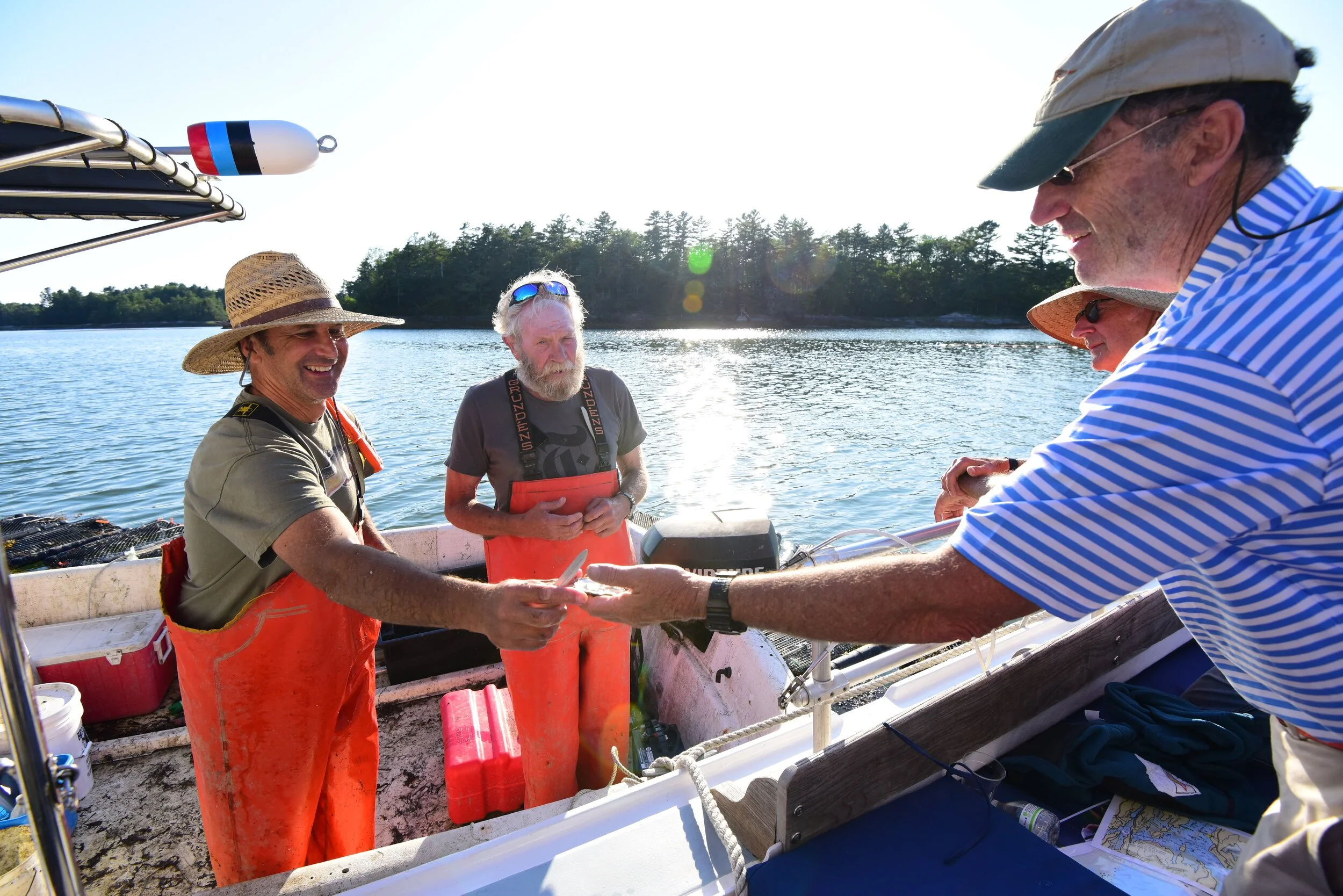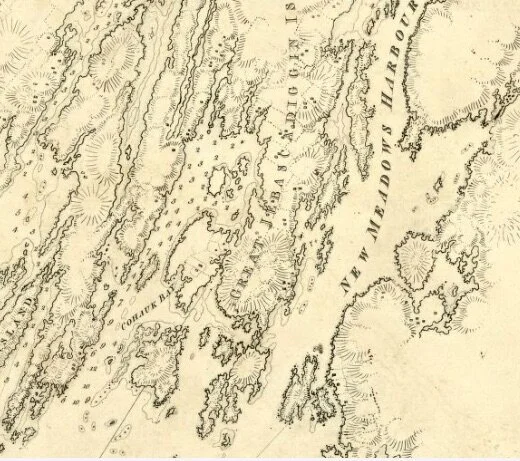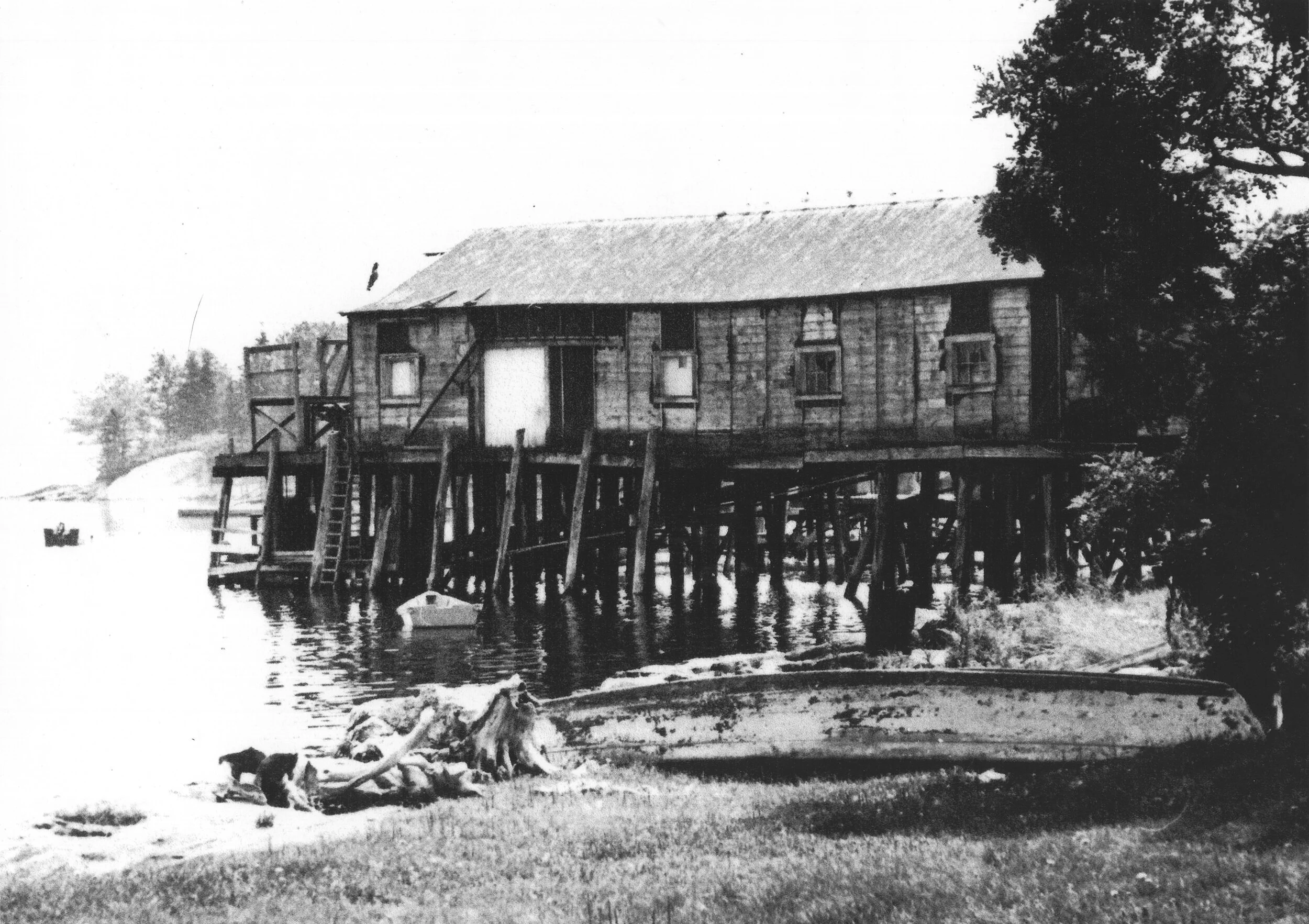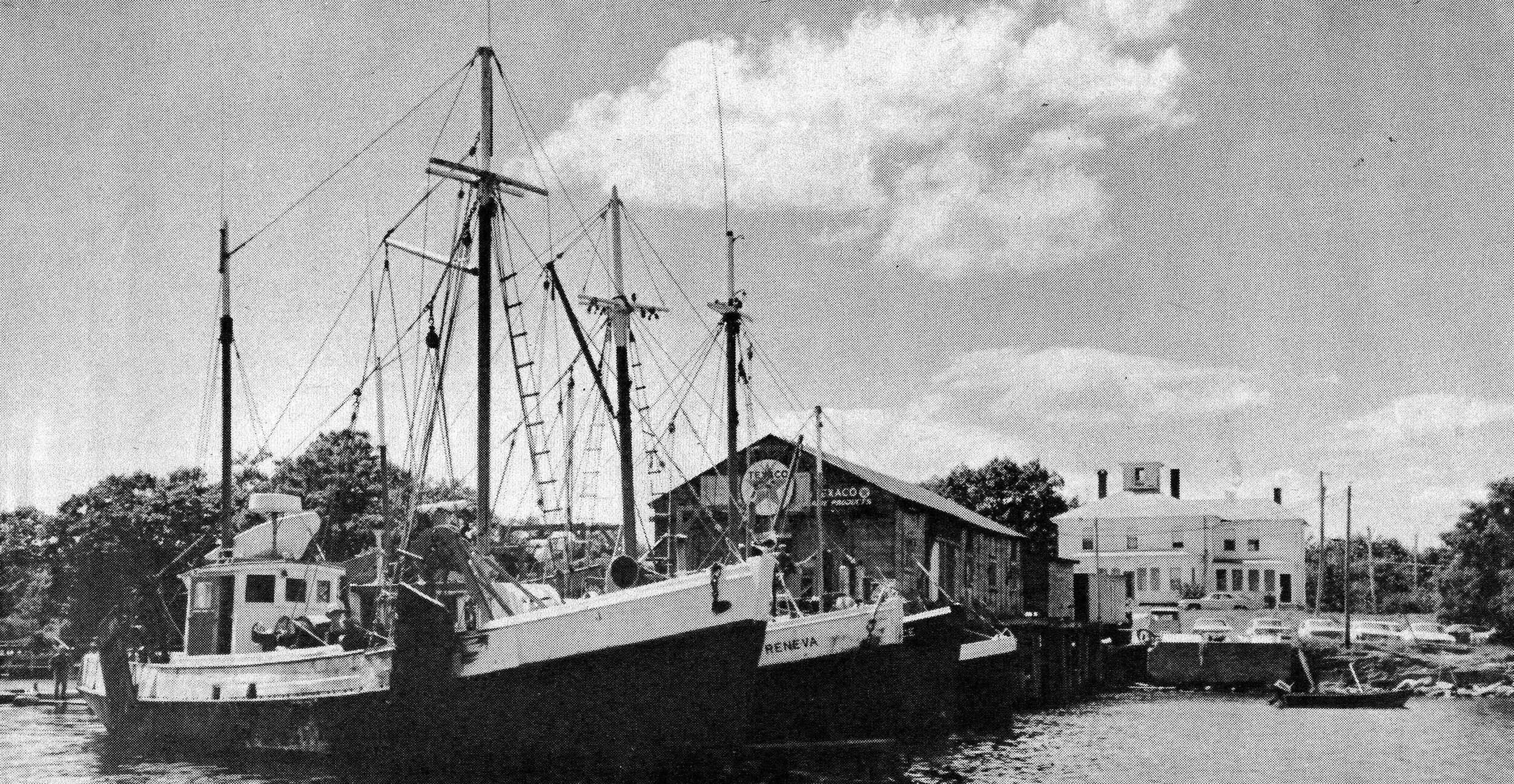OUR HISTORY
Purchase and Renovation
2006-2008
The origins of The Holbrook Community Foundation date to 2002 when a group of Cundy’s Harbor women sought to reinvigorate a small community store called Holbrook’s” on Holbrook’s Wharf. These women gathered like-minded Harpswell citizens and together they amassed substantial support and funding not only to run the store, but also to purchase and renovate the wharf and begin efforts to preserve the Cundy’s Harbor waterfront. By December 2006 they had incorporated Holbrook Community Foundation as a 501(c)(3) organization, raised $1.25 million to purchase the property, including $450,000 from individuals, $50,000 from the Town of Harpswell and a loan from the Genesis Community Loan Fund for $700,000. In 2007, the state established a Land for Maine’s Future (LMF) grant program to help fisheries. In February 2008, HCF received an LMF grant for $300,000 which was used to reduce the Genesis loan.
Safety Repairs, Renovations and Rebuilding 2007-2009
After HCF purchased the property, it made basic safety repairs to the wharf. Between 2007-2009, HCF rebuilt the wharf, built a new snack bar, and renovated the three fishing bays and the house. The house has two private apartments and space for an art gallery. Holbrook’s was now ready to provide storage bays and mooring for local fishermen. Support services were also provided such as bait and a concrete dock strong enough for an 18-wheeler that could take fish and seaweed for processing and to market.
Reopening of the Holbrook Property in 2009
When the renovation was completed, HCF had a reopening in July 2009. The Governor and local representatives of the Maine Senate and the local county political offices attended.
Becoming Financially Self-Sufficient
HCF was able to become increasingly self-sufficient and pay off large sums of its Genesis loan as a result of a combination of income sources and strong local support from the community and town. These sources included: 1) donations from the local community and town, including the donations during the Labor Day breakfast; 2) leasing the restaurant and store each summer; 3) leasing the two apartments and gallery space in the house; and 4) leasing the commercial fishing space, moorings, bait operating, and parking. In 2025 the Genesis loan was paid in full ahead of schedule.
Contributions to the Community
Once HCF became financially self-sufficient, it created the HCF Education Initiative and has supported annual community events. The Education Initiative supports HHLT’s environmental education at their summer camp and at the Harpswell School. Events included the Labor Day Breakfast, Lobster Crate Races, Blind Dinghy Races and Christmas celebrations on the wharf.
200 Years at Holbrook’s Wharf
1776 Royal Navy chart of Casco Bay, including Great Jebascadiggan Island with structures near Cundy’s Harbor. The chart was surveyed by Joseph F. W. Des Barres.
A Brief History of Holbrook’s at Cundys Harbor
In 1823, the schooner Merritt retrieved a foundering ship full of mahogany and towed it to Cundy’s Harbor. The brig Elizabeth and Jane had wrecked near the Fox Islands, lost masts, shattered her hull, and filled with water. Captain Sylvester of the Merritt and his crew saved and sued for the salvage rights to 206 sticks of mahogany and mailed the letters they found aboard in Bath.
The Merritt was built and owned by Stephen Merritt in 1820, the year Maine became a state. That same year. he became a Harpswell selectman. A founder of the East Harpswell Free Will Baptist Church, he also represented Harpswell in Maine’s legislature. Stephen, with his father, Henry, and his son, built, owned, or captained at least twelve ships between 1784 and 1833. Stephen is the earliest link in the chain of ownership of Holbrook’s that begins in 1832. What follows is a brief narrative of the families who have lived and worked on the property that we know as Holbrook’s in Cundy’s Harbor, Maine.
The entire chart is available through the Library of Congress. Search for Atlantic Neptune Portland Port to Stage Island.
Native Americans in East Harpswell
Long before the Merritts (and others) lived in East Harpswell, Native Americans were in what we call Cundy’s Harbor. Prehistoric shell middens investigated by the Pejepscot Historic Society in 1890 contained:“bones of the deer, porpoise, beaver, fox, woodchuck and some smaller carnivorous animals, birds of several kinds, including a well-preserved specimen of the wing bone of the great auk” There were stone implements, pottery shards, and a broken bone awl. Others have found arrowheads and thumb scrapers. A 1664 deed signed by Sagamore chiefs Warumbee, Darumkine, Wihikermet, Wedon-Domhegon, Neonongasset, & Nimbanewe indicates that their tribes fished for salmon and sturgeon.
The 18th Century at Holbrooks
In 1714, the Pejepscot Proprietors bought Sebasco Deggin Island, had it surveyed in 1731, and enlisted John Booker to keep squatters and timber thieves away. In 1733, they leased the island for seven years to William Cady and associates. Cady’s associates included William Condy, for whom the harbor was named. Rent was “twenty good fat geese, or in failure thereof £5 per annum….” Although the renters were expected to build homes, till, and plant orchards, the Proprietors reserved mineral rights and the right to “settle a fishery there.”
Just in time for the Revolution, Joseph F.W. Des Barres charted these waters for the Royal Navy. His July 1776 chart showed Great Jebascadiggin Island divided into farms with a handful of structures in Cundy’s Harbor. See chart above. In 1782, Colonel Nathaniel Purinton sailed from Cundy’s Harbor towards Seguin Island and captured the marauding British ship, Picaroon. His crew included Henry Merritt, father of Stephen, and Stephen Purinton, a future owner of Holbrook’s.
Sidney Watson built this wharf in the 1850’s. The date of the photo is unknown.
The 19th Century at Holbrook’s The Merritt and Purinton Families
Although we do not know when Stephen Merritt acquired his property, we do know that he sold two adjacent properties to John M. Purinton in 1832 and 1835 for $37. Two years later, John sold the land to his father, Stephen, for $1400. The 1837 deed reads:
“…beginning at the waters of New Meadows River at a thorn tree on the bank about one rod South of the Store, thence westerly to the town road thence Northeasterly by the fence to a hole picked in the ledge … with all the buildings standing thereon and wharf .…”
John was not fleecing his father—he had been busy: While the 1832 and 1835 deeds mention the hole picked in the ledge, the thorn tree on the shore, and the store, they lacked buildings and wharf. We know therefore that the first wharf at Holbrook’s was built between 1835 and 1837.
In 1843, Stephen Purinton died, leaving the property to Almira Purinton Merritt, and her husband, Henry Merritt. In 1849, they sold it for $900 to Isaac and John R. Tebbetts. The Tebbetts then sold it to Joseph S. Reed in 1853 for $1830. Reed sold the property to George Garland and Robert Watson a few months later for $1500. Each of the deeds for these sales mentions the thorn tree, the hole picked in the ledge, and the buildings and wharf.
The Watson Family
Robert Watson was the progenitor of the Watsons of Cundy’s Harbor. His son, Sidney, built a new wharf at Holbrook’s between 1853 and 1855. In 1867, Garland and Watson sold two-thirds of the property to Albert Trufant, who had married Watson’s daughter Sarah. By then the thorn tree was gone, replaced by a rock. Trufant processed fish and lobsters there. In June 1865, a reporter for the Brunswick Telegraph interviewed “our friend Trufant” during an excursion to Cundy’s Harbor. In the conversation about reduced fish runs and lower prices compared to 1864, Trufant said,
“The firm have enlarged their works at the Harbor, fitting up an oil house, steam chest for porgies, kettles for boiling lobsters and trying out oil. We saw piles of fish prepared for the Canada and Western New York Markets. For the first, the fish were small haddock, and dried perfectly hard. For the second they were cod, salted…”
A map of Cundys Harbor in 1871. To see the original map, search for “Digital Maine Cumberland 1871 atlas.” Then scroll down to Brunswick and Harpswell.”
The Trufants built the Italianate house, the Holbrook-Trufant house, to raise their children, Albertine, Addie, and William A. Addie and her husband, Frank Ridley, moved a small house to land carved out of the Trufant property in 1885. Frank ran a livery to Brunswick from the barn of the of the Holbrook-Trufant house. In 1898, William A. Trufant opened a store.
Edward and Alice Holbrook. Date unknown.
The 20th and 21st Centuries at Holbrooks
In December 1907, the property became what we know as Holbrook’s. Frank Ridley sold everything to W. Edward Holbrook. Ed, his wife, Alice, and daughter, Christine Miller, ran the store for decades. Setbacks occurred when the original store burned about 1930 and the Great New England Hurricane of 1938 destroyed the dock. In 1945, Ed Holbrook built a new dock. After her father died, in 1954, Christine Miller was a general store operator, postmaster, neighborhood winter social magnet, and fish dealer.
Fishing on the Wharf
Historically, Harpswell men fished for cod, hake, haddock, pollock, cusk, swordfish, mackerel, pogies, herring, sardines, and whiting. Fish were salted and dried, canned, or shipped fresh in ice cut on Dingley Island. In 1880, about 20,000 quintals of fish (2.25 million pounds) were caught and sold in all of Harpswell. Fishermen also dug clams (2500 barrels in 1863 at $8 to $14 per barrel) and caught lobster and shrimp. In 1920, fishing dominated to such an extent that 72% of the 25 working men in Cundy’s Harbor were fishermen. In 1959, as many as 25 local lobstermen supplied Christine Miller with about 100 tons of lobster a year for sale at the store.

